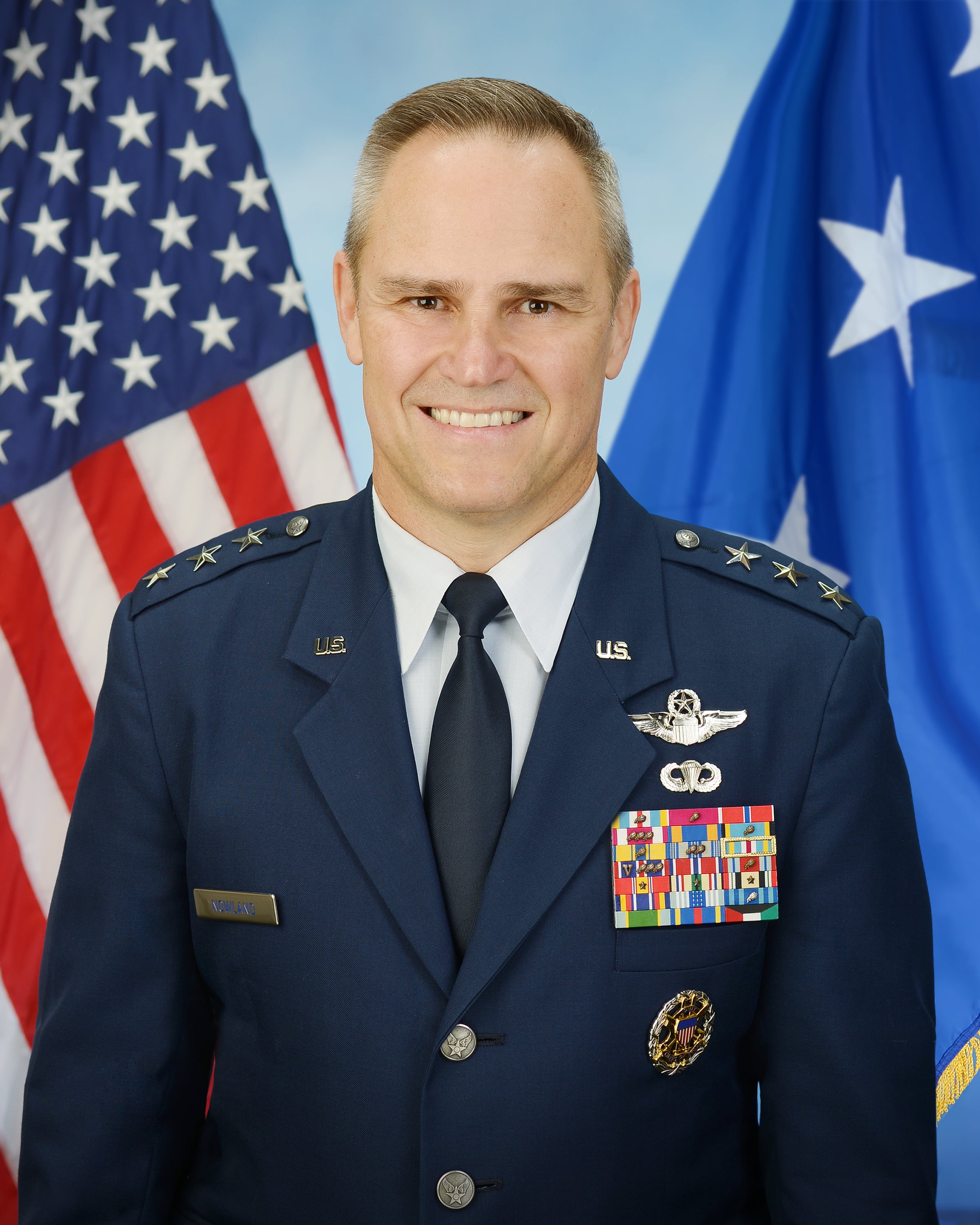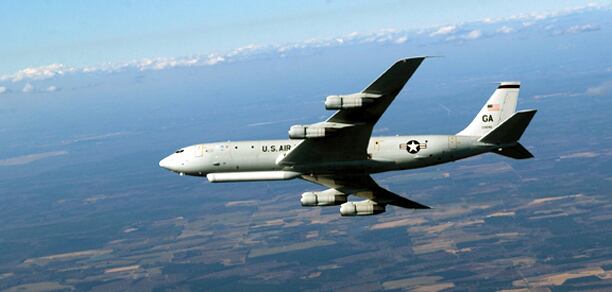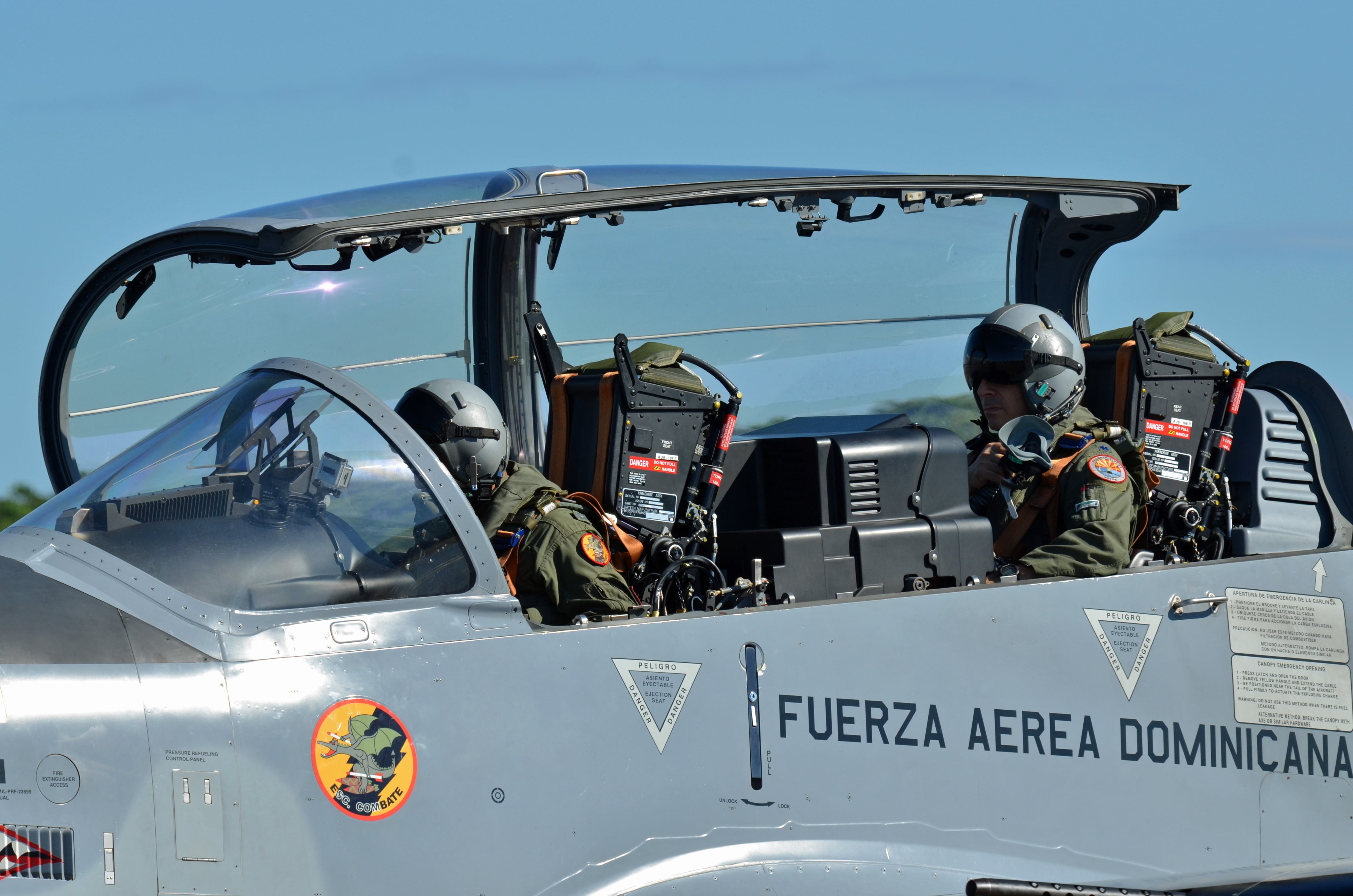As the drug smugglers' go-fast boat streaked across the blue Caribbean Sea in March, carrying more than a thousand pounds of cocaine toward its U.S. destination, they were completely unaware they were being observed from above.
Suddenly, they felt a presence and looked up. Coming at them, low and fast, was the unmistakeable silhouette of one of the nastiest weapons in the Air Force arsenal — a B-1B Lancer, the backbone of America's long-range bomber force.
In a panic, the smugglers scrambled to retrieve all the packages of cocaine aboard and then dumped them over the side one-by-one, like million dollar buoys spreading out in their wake.
One day in March, drug smugglers looked up in the sky while sailing on a boat in the Caribbean Sea. What they saw scared them enough to dump millions of dollars of cocaine into the ocean.
"Think about it," said Lt. Gen. Chris Nowland, commander of the 12th Air Force under at Air Combat Command, and of Air Forces Southern, said at that briefing. "If you’re in the middle of the Caribbean in a go-fast [a speedboat commonly used by drug smugglers] — 40 feet long, four or five 250-horsepower engines — and suddenly a bomber comes out of nowhere and flies over the top of your vessel? It’ll get your attention, to put it mildly."That B-1 bomber wasn't there to blow them out of the water. In fact it was , It was an Air Force B-1 bomber on a routine training mission, Air Force Secretary Deborah Lee James said at an April 15 roundtable briefing with reporters at the Pentagon. But And when the bomber’s crew saw the vessel, they and thought it looked suspicious and they took a low-level pass to check it outidentify them. The fearful panicked smugglers threw an estimated 500 kilos of cocaine overboard.
These situations now currently happen occasionally. But James hopes they become increasingly regular occurrences in Latin America. She wants the Air Force to figure out ways to work more efficiently and provide more assistance to the narcotics interdiction efforts of U.S. Southern Command’s Joint Interagency Task Force-South out of Key West, Florida.
"A little U.S. goes a long way in much of Latin America," James said. "And I intend to look for more ways to get what I call a double bang for our U.S. training buck. I'm going to be looking for additional ways to replicate these types of examples more broadly to leverage other training missions, other aircraft, perhaps helicopter sorties."

The Air Force is working with the Navy and Coast Guard to intercept illegal drug traffic in the Caribbean and Gulf of Mexico. Here, a video taken from the Coast Guard Cutter Bertholf shows drug smugglers heading north in September.
Photo Credit: Coast Guard
"We as Americans, we at our own peril, risk not paying attention to partner nations to the south," Nowland said in a follow-up interview May 2. "The drug lords have morphed themselves from the days of Pablo Escobar. They are the ultimate businessmen, because they don’t have to follow any rules. Cocaine, heroin, precursor chemicals [which are needed to produce other drugs such as methamphetamine], counterfeit consumer goods, wildlife, gold, female trafficking victims — which is the grossest one of all — to weapons, to smuggling migrants, to timber, to moving bulk cash. They’ve diversified, and they’re worldwide now."As the Air Force has been occupied fighting wars in Iraq and Afghanistan, bolstering European allies nervous about Russian aggression, and beefing up its forces in Asia, Latin America has faded to the background. That needs to change, James said. Not only do Latin American countries need assistance with counternarcotics efforts and stopping destabilizing cartels and other transnational organized crime, they need American assistance to train and improveing and training their own air forces and help with with other missions, such as humanitarian assistance peacekeeping.
And it's not just the for-profit criminals concerning Nowland. If drug smugglers can slip through from the south, so can terrorists.

"We as Americans, at our own peril, risk not paying attention to partner nations to the south," says Lt. Gen. Chris Nowland, commander of the 12th Air Force under Air Combat Command, and of Air Forces South. "We don't want to have an open door on the southern flank of the United States."
Photo Credit: Air Force
"If you can move all these tons of cocaine or you can move the sex slaves or the precursor chemicals, it doesn’t mean that other people couldn’t move stuff," Nowland said of fanatical militantsideological groups such as terrorists. "We don’t want to have an open door on the southern flank of the United States."
But wWith ongoing missions in places like Iraq and Syria unlikely to lessen anytime soon, the Air Force simply doesn’t have airmen or aircraft to spare for a new counternarcotics mission. But B-52 aircraft assigned to its nuclear enterprise mission, for example, are always going to need to regularly fly long-distance training missions on a regular basis to stay sharp.
"We have to live with the hand that we're dealt," James said. "I can't suddenly materialize and produce lots of additional aircraft for the Air Force, lots of additional budget. But … training missions have to occur anyway. And if we can target some additional tours in this region then I think we could advance the ball."
It shouldn’t take much to produce results, James said, although she couldn’t quantify how much the Air Force’s efforts in Latin America could increase. She’s ordered the Air Force’s deputy chief of staff for operations, Lt. Gen. John Raymond, to redouble his efforts to find ways to piggyback missions such as counternarcotics on top of already -required training missions to increase the service’s reach.

The E-8C Joint Surveillance Target Attack Radar System uses a multi-mode side looking radar to detect, track and classify moving vehicles on the water.
Photo Credit: Staff Sgt. Shane Cuomo/Air Force
Nowland called the practice of combining multiple missions into individual sorties to help JIATF-South "force packaging."
"The beauty is, when you can take the different assets and put them together, you can increase situational awareness, you get better training, and you get better results," Nowland said.
Another example of force packaging — albeit one without a counter-narcotics element — came in early April, when a B-52 Stratofortress from Minot Air Force Base in North Dakota flew a 27-hour nonstop, long-range training sortie to South America. First, the B-52 trained with the Colombian air force and conducted a planned intercept exercise with a Lear jet and the Colombians' Israeli-made F-21 Kfir fighter jets. Then it , and then conducted a flyover at the massive Feria Internacional del Aire y del Espacio air show in Santiago, Chile.
But cCounter-narcotics missions aren’t simply an airpower show, however, – they’re multi-domain operations in which where the Air Force works hand-in-hand with forces such as the Navy, the Coast Guard, Customs and Border Protection and the militaries of Latin American allies.
JIATF-South is an international, interagency task force that allows all five military services, intelligence agencies, law enforcement agencies such as Customs and Border Protection, the Drug Enforcement Administration and the FBI, and liaison officers from nations such as Brazil, Colombia and Ecuador to share radar information and work together to detect and monitor illicit trafficking of drugs and other contraband.
"Just like we have in the Five Eyes, where we can share [intelligence] information [with Australia, Canada, New Zealand and the United Kingdom], they have information we can share with our partner nations," Nowland said. "JIATF-South is excellent at … layering the intelligence so that you have a higher probability, every time you go after a drug trafficker, of success. It's exactly the same type of thing we do in the fight against [the Islamic State]. We don't have enough assets, so the days of just putting an airplane out there to just cruise around the ocean to find a go-fast, you can't afford to do that. So you need to use intelligence to help shape your operation."

Drug runners have become increasingly sophisticated in their attempts to evade deterction. Here, a Coast Guard Cutter Stratton boarding team investigates a self-propelled semi-submersible interdicted in international waters off the coast of Central America. The Air Force brings critical assets and experience to the table that no other service or agency has, said Coast Guard Rear Adm. Christopher Tomney, director of JIATF-South.
Photo Credit: LaNola Stone/Coast Guard
Coast Guard Rear Adm. Christopher Tomney, director of JIATF-South, said the Air Force brings critical assets and experience to the table that no other service or agency has.
"There's more than enough work to go around, and we don't have enough assets," Tomney said in a May 18 interview. "There are not enough aircraft to go around to search 40-plus million square nautical miles and keep a persistent presence to make sure we can monitor all that illicit activity.
"[Doing so] requires aircraft with the appropriate sensors, with the appropriate endurance, that can cover large swaths of water to find that small target, that target that doesn't want to be found, that target that's trying to do something illegal," he said. "That's why the Air Force is so critical, being that eye in the sky for us."
A common practice, Nowland said, is to have E-8 Joint Surveillance Target Attack Radar Systems, or JSTARS, aircraft take off from bases such as Robins Air Force Base in Georgia and head to a spot in the Caribbean where JIATF-South thinks might have some activity. Operating alongside other aircraft, such as CBP or Navy P-3s, the JSTARS uses its intelligence, surveillance and reconnaissance capabilities to scan wide swaths of the ocean for suspicious vessels.
If a JSTARS aircraft spies a possible drug boat, Nowland said, it can signal a B-1 or B-52, which can use its speed and range to quickly reach the boat and identify whether or not it is engaged in smuggling. If a bomber isn't available, the Air Force could call in a C-130 or a P-3.
The bomber — which would typically fly out of Southern bases such as Barksdale Air Force Base in Louisiana or Dyess Air Force Base in Texas — or another aircraft then fixes the suspected drug boat with its sniper pod to visually identify it. But bBecause the Air Force has no law enforcement authority, it needs to call in the Coast Guard, or a Navy ship with Coast Guard personnel aboard, to track the drug boat, make arrests and confiscate the drugs or other contraband.
In addition to Besides taking drugs out of the supply chaincirculation, Nowland said, such that exercises provides valuable command and control training. The aircrews get experience talking to other aircraft, headquarters such as JIATF-South, Navy and Coast Guard ships run by other services such as the Coast Guard and Navy, and helicopters and rigid inflatable boats launched from Coast Guard cutters.
"We can get training all the way through the command and control network, all the way down to talking to a Coast Guard vessel on the water and actually talking to the Coast Guardsmen who are then using their legal capability to interdict that," Nowland said.
When flying over water, the JSTARS' radar can scan 10 times the amount of territory as a traditional maritime patrol aircraft such as a P-3, Nowland said.
"That's why JIATF loves them, because they're super-efficient, they can cover such a great space," Nowland said. "But this is a problem for us. JSTARS right now is having big depot issues and half of the fleet is in depot status. So, unfortunately for us, that limits our ability to get the JSTARS out over the water as much as we would like to."
When scanning the ocean, JSTARS air crews looks for suspicious patterns to separate drug boats from legitimate vessels. For example, smugglers in a semi-submersible — a craft that operates just below the surface, leaving a snorkel-like structure above water for air — might occasionally disappear from the radar. That is a red flag for airmen looking for drug smugglers, Nowland said.
Nowland would not say how often these missions are conducted, but said the frequency ebbs and flows, in part based on aircraft’s' availability.

A pair of E-3 Sentry Airborne Warning and Control System aircraft at Forward Operating Location Curacao can provide aerial detection and monitoring of suspected air and maritime drug trafficking activities.
Photo Credit: Air Force
The vast majority of drug smuggling — roughly 93 percent — is done over the seas. But the Air Force also uses E-3 Sentry AWACS aircraft temporarily assigned to from the 429th Expeditionary Operations Squadron at Forward Operating Location Curacao, an island nation just north of Venezuela, to search for airborne drug smugglers, Nowland said.
But what the Air Force does with that information depends on which nations are involved, and those nations’ policies on shooting down drug planes, Nowland said. For example, the United States stopped sharing radar intelligence with Honduras in 2014, after that nation passed a law allowing it to shoot down smugglers'ing planes.
"Legally, that puts our airmen at risk" if they passed on information that iswas then used to kill non-combatants, even if they are drug smugglers, Nowland said.
Instead of alerting Honduras, JIATF-South would keeps its own eye on that plane and notes where it goeswent.
But for Colombia, which has stricter shoot-down rules limiting how its military can engage with aircraft, JIATF-South would passes on the radar information so the Colombians y can interdict it on the ground. Colombia is now the only nation with an air interdiction program with which the U.S. shares real-time information, and uses force to try to get an airplane to land "only as a last resort, in very limited circumstances," JIATF-South said.
Nowland said that he would like to start rolling the Air National Guard and Air Force Reserve training missions into force packaging as well.
Meanwhile, the Border Patrol Nowland also said CBP is trying to use radar-mounted MQ-1 Predator drones to expand the government’s view of the smuggling routes, and give Air Force surveillance aircraft a boost, he said. But that proposal has not yet been approved.
"Worldwide, that would take our [remotely -piloted aircraft] community to the next level," Nowland said.
One airman who works as an Air Force liaison to JIATF-South — Senior Airman Cesar, who declined to give his last name — said for him, the mission is personal.

Lt. Col. Eric Perlman, a U.S. Air Force F-16 instructor pilot, prepares to ride in the back seat of a Dominican Republic air force A-29 Super Tucano as part of an exercise to combat illegal drug trafficking in 2013. Training Latin American air forces remains an important part of the U.S. Air Force's counternarcotics mission.
Photo Credit: Capt. Justin Brockhoff/Air Force
"I come from Puerto Rico, and seeing all the mayhem and damage that it does motivated me to volunteer to work in this area," SrA Cesar said. "All the way from middle school, I saw friends drop out from school, high school, even college. The crime rate going up, organized crime. Just seeing this growing up, and then you're given one chance to have a hand in changing it, it was really a huge thing for me."
From March 2015 to April 2016, Nowland said the Air Force conducted 278 hours of force-packaged counter-narcotics flight operations and helped with the interdiction of 14 metric tons of cocaine worth roughly $437 million.
In all, JIATF-South took 192 metric tons of cocaine off the high seas in 2015, Nowland said. And so far this year, JIATF-South has already interdicted 140 metric tons of cocaine.
But that's barely a drop in the bucket of the nearly $650 billion the cartels rake in each year. Cocaine alone is an $85 billion a year industry around the world. And Nowland is concerned that, with cartels' cocaine production up sharply these days, JIATF-South has its work cut out for it, just trying to keep up.
"Even though we've gotten 140 metric tons this year, JIATF-South has watched a lot of drugs go right by," Nowland said. "Are you going to be able to stop everything? No, but the more you stop, the better."
Stephen Losey is the air warfare reporter for Defense News. He previously covered leadership and personnel issues at Air Force Times, and the Pentagon, special operations and air warfare at Military.com. He has traveled to the Middle East to cover U.S. Air Force operations.





